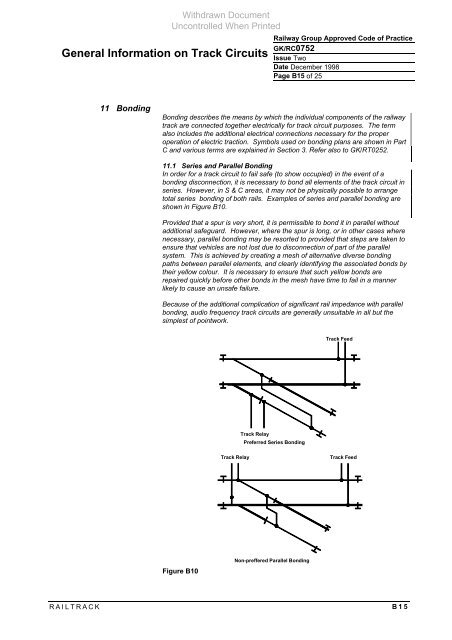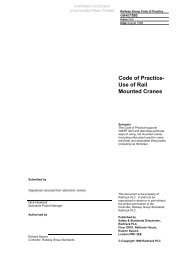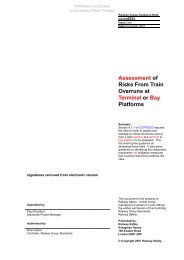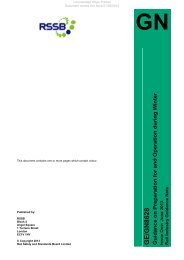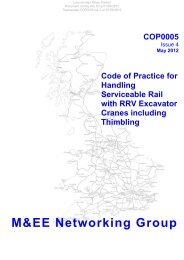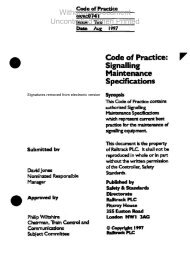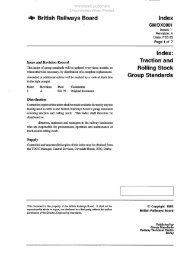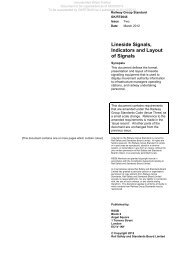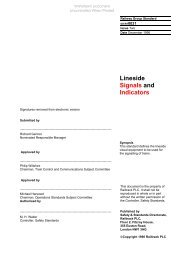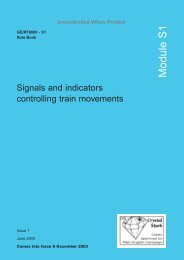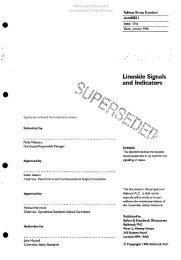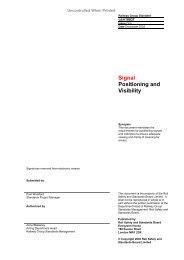General Information on Track Circuits - RGS Online
General Information on Track Circuits - RGS Online
General Information on Track Circuits - RGS Online
You also want an ePaper? Increase the reach of your titles
YUMPU automatically turns print PDFs into web optimized ePapers that Google loves.
<str<strong>on</strong>g>General</str<strong>on</strong>g> <str<strong>on</strong>g>Informati<strong>on</strong></str<strong>on</strong>g> <strong>on</strong> <strong>Track</strong> <strong>Circuits</strong><br />
11 B<strong>on</strong>ding<br />
Withdrawn Document<br />
Unc<strong>on</strong>trolled When Printed<br />
Railway Group Approved Code of Practice<br />
GK/RC0752<br />
Issue Two<br />
Date December 1998<br />
Page B15 of 25<br />
B<strong>on</strong>ding describes the means by which the individual comp<strong>on</strong>ents of the railway<br />
track are c<strong>on</strong>nected together electrically for track circuit purposes. The term<br />
also includes the additi<strong>on</strong>al electrical c<strong>on</strong>necti<strong>on</strong>s necessary for the proper<br />
operati<strong>on</strong> of electric tracti<strong>on</strong>. Symbols used <strong>on</strong> b<strong>on</strong>ding plans are shown in Part<br />
C and various terms are explained in Secti<strong>on</strong> 3. Refer also to GK/RT0252.<br />
11.1 Series and Parallel B<strong>on</strong>ding<br />
In order for a track circuit to fail safe (to show occupied) in the event of a<br />
b<strong>on</strong>ding disc<strong>on</strong>necti<strong>on</strong>, it is necessary to b<strong>on</strong>d all elements of the track circuit in<br />
series. However, in S & C areas, it may not be physically possible to arrange<br />
total series b<strong>on</strong>ding of both rails. Examples of series and parallel b<strong>on</strong>ding are<br />
shown in Figure B10.<br />
Provided that a spur is very short, it is permissible to b<strong>on</strong>d it in parallel without<br />
additi<strong>on</strong>al safeguard. However, where the spur is l<strong>on</strong>g, or in other cases where<br />
necessary, parallel b<strong>on</strong>ding may be resorted to provided that steps are taken to<br />
ensure that vehicles are not lost due to disc<strong>on</strong>necti<strong>on</strong> of part of the parallel<br />
system. This is achieved by creating a mesh of alternative diverse b<strong>on</strong>ding<br />
paths between parallel elements, and clearly identifying the associated b<strong>on</strong>ds by<br />
their yellow colour. It is necessary to ensure that such yellow b<strong>on</strong>ds are<br />
repaired quickly before other b<strong>on</strong>ds in the mesh have time to fail in a manner<br />
likely to cause an unsafe failure.<br />
Because of the additi<strong>on</strong>al complicati<strong>on</strong> of significant rail impedance with parallel<br />
b<strong>on</strong>ding, audio frequency track circuits are generally unsuitable in all but the<br />
simplest of pointwork.<br />
Figure B10<br />
<strong>Track</strong> Relay<br />
Preferred Series B<strong>on</strong>ding<br />
<strong>Track</strong> Feed<br />
<strong>Track</strong> Relay <strong>Track</strong> Feed<br />
N<strong>on</strong>-preffered Parallel B<strong>on</strong>ding<br />
RAILTRACK B15


